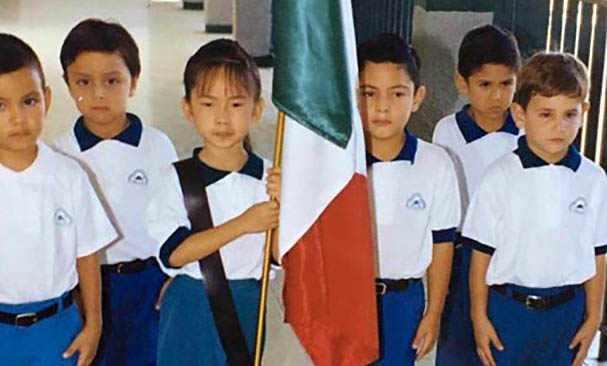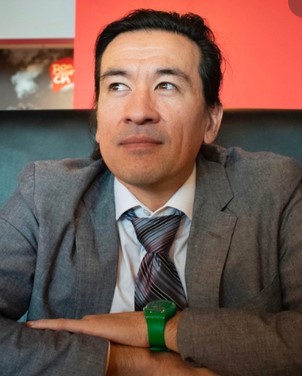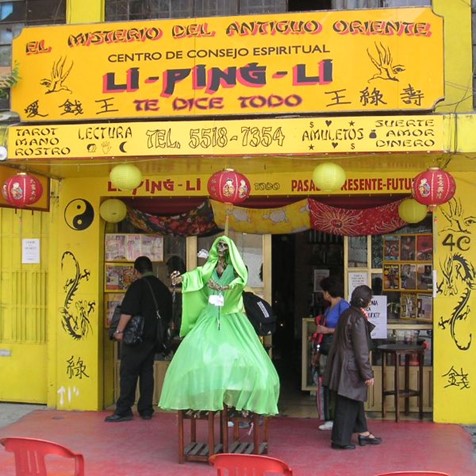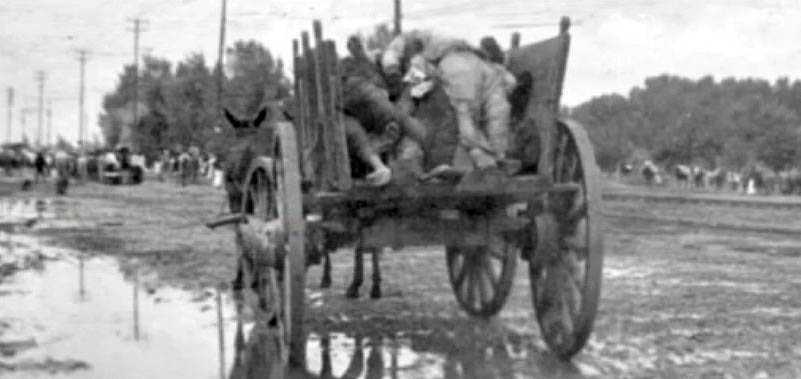|
|
|
|
The weekly newsletter of the México Solidarity Project |
|
|
|
September 1, 2021/ This week's issue/ Meizhu Lui, for the editorial team |
|
|
Chinese — and Mexican, Too? Absolutely Yes! |
|
My Chinese-American son grew up facing a mocking schoolyard sneer: “You’re not white, you’re not black, you’re nothing!” For kids growing up Chinese, figuring out where you belong — and how to belong — can really get hard. So they grow up mixed-up.
This dynamic of being literally “out of place” has deep roots. In both the US and México, the first generation of Chinese — the workers who tunneled through mountain rock and traversed blistering deserts laying the rails that would bring products and profits throughout the US and México — found no welcome mats or thank-you casseroles. Both the US and México wanted the Chinese to “go home.” In the 1930s, México deported 70 percent of Chinese-Mexicans, including those of mixed race. They didn’t “fit” with the Mexican racial order.
And what order did that happen to be? After the Revolution, México decided on mestizo as its national identity. Mestizo means “mixed,” but not just any old mix, just specifically the mix between European Spanish colonizers and México’s indigenous peoples. Unlike the US, México didn’t make it illegal for the Chinese to marry someone of another race. But if they did, if they married a Spanish or indigenous mate, their children would still not fit in. In the eyes of Mexican society, better that they “go home,” an all-too-frequent taunt yelled at me as an American-born Chinese.
Today, with people migrating around the globe at an ever faster pace, we’re seeing ever more mixing. Let’s create societies where mixed-race children can be fully accepted and proud of their mix. Instead of just mixed-up. |
|
|
Historian Jason Chang, in his 2017 book Chino: Anti-Chinese Racism in Mexico, 1880-1940, explores how the racial image of the Chinese has shifted since the Mexican Revolution — and how anti-Chinese racism, antichinismo, has influenced the evolution of México’s mestizo national identity. Chang currently directs the University of Connecticut’s Asian and Asian American Studies Institute.
In many tiny villages around the world, you’ll be surprised to find a Chinese restaurant! When did the Chinese arrive in México? |
|
|
Chinese laborers began migrating to the Americas in the 1800s, both voluntarily to earn money to send home and recruited as “coolie labor” to work in the toughest jobs for the lowest pay. In the US, racism against the Chinese resulted in the Exclusion Acts of 1882 — legislation that barred them from entry — and this resulted in an influx of Chinese into México. Mexicans at that time could freely go back and forth across the border. Some Chinese took this backdoor route and entered the US disguised as Mexicans!
But starting in the 1890s, under the dictatorship of Porfirio Díaz, British and American companies also gained contracts with the Mexican government to build railroads, and these companies needed workers to lay track. That led to the import of Chinese labor. By the time of the Mexican Revolution, the Chinese had become México’s second-largest immigrant group.
During that Revolution, in 1911, the “good guys” fighting to overthrow the dictatorship massacred hundreds of Chinese in Torreón. What made the Chinese so hated?
Many Mexicans associated the Chinese with the Díaz regime, because President Díaz had imported Chinese labor. So hating them became a way of opposing the dictatorship. Many of the Chinese had also been able to save enough to start small businesses — like, yes, restaurants or grocery stores, gardens, and even a Chinese bank. The more successful they became, the more resentment they felt.
In Torreón, a mob of revolutionary forces, plus townspeople, went on an a spree of atrocities. They viciously killed 303 Asian-Mexican men, women, and children, half the town’s local population. The massacre destroyed the Chinese community. By some estimates, Chinese households lost a million-dollars worth of assets in a horror similar to the 1921 massacre of successful African-Americans in Tulsa, Oklahoma.
The United States denied Chinese workers entry, citizenship, and the right to marry white women. Did México enact similar restrictions?
México never completely banned Chinese immigration or naturalization. And Chinese men could marry Mexican women. But race has always been a tricky concept in México. The first conquistador married an indigenous woman, and their union produced the first mestizo. With no white women around, marriage and rape continued to produce mixed children. Not until the Revolution did the term mestizo get adopted as the national racial identity. That said, the European side, the conqueror side, always remained dominant in terms of cultural norms, and México had plenty of racists who saw mestizaje, intermixing, as a step toward whitening their society. |
|
In the US, Asian-Americans found their identity and voice during the Civil Rights movement. Has México had an Asian-Mexican movement?
No, México has no parallel to the US Civil Rights movement, partly because racial identity in México has been more fluid than the white/non-white binary. Besides, Chinese immigrants since the 1940s have tended to be business people — pragmatic, accommodating to what the situation is rather than trying to achieve what isn’t. They and their Mexican-born children see education and hard work as the only path to getting ahead. |
|
|
How integrated into Mexican society have the Chinese in México become?
México City has a Chinatown, but the borderlands have been where the Chinese have had a particular impact. Border communities create a kind of third space where neither the norms of México nor the US apply. The resulting hybrid culture — a Mexican way of being Chinese — involves having an accumulation of experiences with racism and having adapted to it. The Chinese have become a normal part of borderlands culture and have helped make the borderlands what they are.
President López Obrador has issued a formal public apology for the Torreón massacre.
Yes, a population that was invisible has now become more visible. AMLO’s apology partly reflects the desire of both China and México to cooperate economically. But the apology also represents a healthy new recognition of marginalized and oppressed people — and an opening for sharing their histories, their contributions, and their stories. |
|
|
‘Let’s kill the Chinese!’: A Massacre Remembered |
|
This past May President Andrés Manuel López Obrador journeyed north from México City to recognize — and apologize — for the 1911 massacre of over 300 Chinese in the city of Torreón. The Guardian’s David Agren subsequently supplied this background. |
|
|
The first to die were Chinese agricultural workers, who were killed in the orchards and gardens surrounding the Mexican city of Torreón by advancing revolutionary forces in the early hours of 13 May 1911.
As the rebels entered the city, they were joined by thousands of locals, fired up by racist speeches. A herb-seller is said to have clutched a Mexican flag and screamed: “Let’s kill the Chinese!” Over the next 10 hours, the mob sacked Chinese-owned businesses, looted the Chinese bank and dragged their Chinese neighbors by their distinctive braids, trampling them to death with horses. Everyone joined in the killing. It was soldiers, men, women — everyone.
A total of 303 Chinese people were murdered in this burgeoning railway town some 500 miles south of the US border. Afterwards, rebels and locals posed for photographs with the bodies of their victims before they were hauled away by the cartload.
In Torreón, nobody was ever charged — let alone tried or convicted — over the massacre, and today the events of 1911 remain largely unmentioned. In Torreón no monuments mark the massacre. A commemorative plaque was swiftly stolen. A statue erected in a public park in 2007 was vandalized and later removed. |
|
However, in May 2021, President Andrés Manuel López Obrador traveled to Torreón to seek forgiveness for the massacre as part of a year-long series of events marking some of the darker chapters in Mexico’s history.
“I think [AMLO’s] visit is important and the event merits this. But the [Chinese] community is not requesting it,” said Antonio Lee Chairez, 90, whose father Juan Lee survived the massacre with the help of neighbors. “But it has to be positive [that he is coming] — because this was an outrage that nobody ever admitted.” |
|
|
|
Recent news reports and commentaries, from progressive and mainstream media,
Ian Millhiser, The Supreme Court’s stunning, radical immigration decision, explained, Vox. In backing Trump’s “Remain in Mexico” policy, the Supreme Court has handed down an order that makes no sense.
John Ackerman, Dignidad rebelde y la 4T: Ana Lilia Rivera, Dialogos por la Democracia. El reto más grande que tiene Morena es la democratización interna del partido.
Rubén Gallo, México's Little-Known Attempt to Save Freud From the Nazis, MIT Press Reader. Had the labor movement campaign to bring Sigmund Freud to México succeeded, the imperiled psychoanalyst would have found himself living among the world’s foremost artists and intellectuals.
Las trabajadoras y trabajadores de General Motors, Silao, consiguieron una histórica victoria, industriALL. Esta victoria histórica en un marco sin precedente.
Angelika Albaladejo, Will Investing in Community Groups Keep Immigrants Out of Detention? Capital & Main. Advocates say the new approach could help transform the US immigration system.
Ben Smith, How México Helped The Times Get Its Journalists Out of Afghanistan, New York Times. Mexican officials, unlike their counterparts in the United States, proved able to cut through the red tape of their immigration system.
Minor Mexican parties prepare to hold new sway in congress, Bnamericas. Morena now has a total of 198 seats of the 500 in the lower house, with its two allies, the socialist labor party (PT) with 37 and the Verde, or green party (PVEM) with 43. Morena needs both to achieve a simple majority.
Popularidad de AMLO, intacta; gran mayoría de mexicanos lo respaldan, Polemón. A diferencia de otros ex mandatarios mexicanos de la época del PRIAN, la aprobación del Presidente Andrés Manuel López Obrador se mantiene intacta a la mitad de su sexenio.
Mexican Authorities Attack Caravan of U.S.-Bound Asylum Seekers, Democracy Now! The caravan included people from Haiti, Central America, Cuba, and Colombia, all blocked from leaving the southern state of Chiapas during the processing of their cases. |
|
|
The Mexico Solidarity Project brings together activists from various socialist and left organizations and individuals committed to worker and global justice who see the 2018 election of Andrés Manuel López Obrador as president of México as a watershed moment. AMLO and his progressive Morena party aim to end generations of corruption, impoverishment, and subservience to US interests. Our Project supports not just Morena, but all Mexicans struggling for basic rights, and opposes US efforts to undermine organizing and México’s national sovereignty.
Editorial committee: Meizhu Lui, Bruce Hobson, Bill Gallegos, Sam Pizzigati. We welcome your suggestions and feedback. Interested in getting involved? Drop us an email! |
|
|
|
Web page and application support for the México Solidarity Project from NOVA Web Development, a democratically run, worker-owned and operated cooperative focused on developing free software tools for progressive organizations. |









